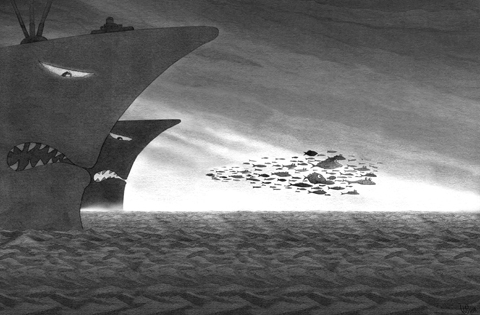The rage for sushi and sashimi, Japan’s raw fish dishes that overtook the West and have now spread to increasingly prosperous China, risks wiping out one of the Mediterranean’s most emblematic residents: the bluefin tuna.
Experts say too many of these majestic fish prized since Greek and Roman times — each one of which can weigh up to 900kg — are ending up on the platters of restaurants around the globe.
“Japanese consumption was already a threat to bluefin tuna in the Mediterranean. The European craze for sushi bars has added to that,” said Roberto Mielgo Bregazzi, a Spanish expert and author of several reports for Greenpeace and the World Wildlife Fund.

”If the Chinese market continues to grow, that will be the end of the stock,” he said.
Eating Japanese-style raw fish in rice packages spread to Europe and the US in the 1990s and quickly grabbed palates there.
China seems to be next, said Bregazzi who added that there had been a significant increase in tuna consumption there in the past six years.
Even though there are few official figures on Chinese consumption, the trend has also been observed by the International Commission for the Conservation of Atlantic Tunas (ICCAT), a body responsible for managing bluefin tuna fishing.
Japan, however, remains the main consumer of bluefin tuna.
“Around 80 percent to 85 percent of bluefin tuna caught in the Mediterranean is exported to Japan,” said Jean-Marc Fromentin, a leading worldwide expert on the subject at the French Research Institute for Exploitation of the Sea.
Sushi consumption took off after World War II, largely using southern bluefish tuna then found in huge numbers off the coast of Australia.
“This stock has now collapsed thanks to over-fishing, and the Japanese turned their attention to the Atlantic bluefin tuna,” said Fromentin, adding that despite its name, Atlantic bluefin comes mainly from the Mediterranean.
Prices began to climb. Fishing fleets were modernized in Europe and new fishing fleets were created in Turkey and northern Africa. The result — a huge overcapacity in fishing.
Today more than 50,000 tonnes of bluefin tuna are caught every year in the Mediterranean. To prevent stocks from collapsing, that figure should be limited to 15,000 tonnes in the short term, ICCAT said.
“The bluefin tuna industry is in the process of fishing itself to death,” Greenpeace oceans campaigner Karli Thomas said.
The risk now is that the depletion of tuna will wipe out the fishing sector, and cost thousands of jobs in the Mediterranean region.
In May and June, fishermen from France, Italy, Libya, Malta, Spain, Tunisia and Turkey are under pressure to maximize their catch. Most use a net called a “purse seine,” which is weighted to reach the sea floor, with hoops and ropes which allow the fishermen to pull the drawstrings and trap the bluefin tuna within the net.
They work out of ultra-modern trawlers, up to 60m long and costing around 5 million euros (US$8 million).
At this point in the chain, a kilo of bluefin tuna fetches the fisherman between 8 euros and 10 euros. The catch is sold to tuna fattening farms, many located in Cypriot, Croatian, Maltese, Sicilian, Spanish and Tunisian waters and many owned by Japanese companies like Mitsubishi, Maruha or Mitsui or the Spanish group Ricardo Fuentes e Hijos.
The tuna are transported to these offshore farms in huge circular cages 50m in diameter and 23m deep. Once in the tuna farms, or ranches as they are sometimes known, the tuna gorge on tonnes of sardines, mackerel and herring.
This boosts their weight to the demands of the Japanese buyers. Some farms also feed the tuna freeze-dried garlic to stimulate their blood circulation or prawns to boost their reddish tinge.
It takes between 9kg and 20kg of small fish to put 1kg of weight on a bluefin tuna, said a co-owner of the Fish and Fish Farm in Malta, Joseph Caruana.
The fattened tuna are then sold at around 13 euros per kilogram to Japanese buyers, who in turn sell them for a much higher price in Tokyo — where a good quality, 200kg tuna can fetch up to 20,000 euros.
“It is the big firms that push the fishermen into over-fishing,” Bregazzi said.
In theory, the bluefin tuna harvest is monitored so that the ICCAT quotas are respected, but there are numerous flaws.
This year, the European Commission — the EU executive — has clamped down somewhat. Fishing was even put on hold for 15 days for some countries — a decision that infuriated French and Italian fishing fleets in particular.
“But the Turkish tuna seiners continued to fish, and there is always the illegal fishing by Japan and [South] Korea,” French fisherman Andre Fortassier said.
Fishing and farms have also developed in non-EU countries in recent years, including Libya, Tunisia and Algeria where quota controls tend to be looser, industry sources said.
For Sergi Tudela, a Spanish marine biologist with Worldwide Fund for Nature, the responsibility lies with ICCAT.
“If important parties in ICCAT such as the US, the European Union and Japan decide to put an end to this unsustainable situation and to adopt real recovery measures, the other countries should accept them,” he said.
“Japan is the key market. If there is a real willingness from Japan to ensure that only real sustainable production is being imported, they can implement that,” Tudela said.
“The potentiality is there, it only lacks political will,” he said.

On May 7, 1971, Henry Kissinger planned his first, ultra-secret mission to China and pondered whether it would be better to meet his Chinese interlocutors “in Pakistan where the Pakistanis would tape the meeting — or in China where the Chinese would do the taping.” After a flicker of thought, he decided to have the Chinese do all the tape recording, translating and transcribing. Fortuitously, historians have several thousand pages of verbatim texts of Dr. Kissinger’s negotiations with his Chinese counterparts. Paradoxically, behind the scenes, Chinese stenographers prepared verbatim English language typescripts faster than they could translate and type them
More than 30 years ago when I immigrated to the US, applied for citizenship and took the 100-question civics test, the one part of the naturalization process that left the deepest impression on me was one question on the N-400 form, which asked: “Have you ever been a member of, involved in or in any way associated with any communist or totalitarian party anywhere in the world?” Answering “yes” could lead to the rejection of your application. Some people might try their luck and lie, but if exposed, the consequences could be much worse — a person could be fined,
Taiwan aims to elevate its strategic position in supply chains by becoming an artificial intelligence (AI) hub for Nvidia Corp, providing everything from advanced chips and components to servers, in an attempt to edge out its closest rival in the region, South Korea. Taiwan’s importance in the AI ecosystem was clearly reflected in three major announcements Nvidia made during this year’s Computex trade show in Taipei. First, the US company’s number of partners in Taiwan would surge to 122 this year, from 34 last year, according to a slide shown during CEO Jensen Huang’s (黃仁勳) keynote speech on Monday last week.
When China passed its “Anti-Secession” Law in 2005, much of the democratic world saw it as yet another sign of Beijing’s authoritarianism, its contempt for international law and its aggressive posture toward Taiwan. Rightly so — on the surface. However, this move, often dismissed as a uniquely Chinese form of legal intimidation, echoes a legal and historical precedent rooted not in authoritarian tradition, but in US constitutional history. The Chinese “Anti-Secession” Law, a domestic statute threatening the use of force should Taiwan formally declare independence, is widely interpreted as an emblem of the Chinese Communist Party’s disregard for international norms. Critics